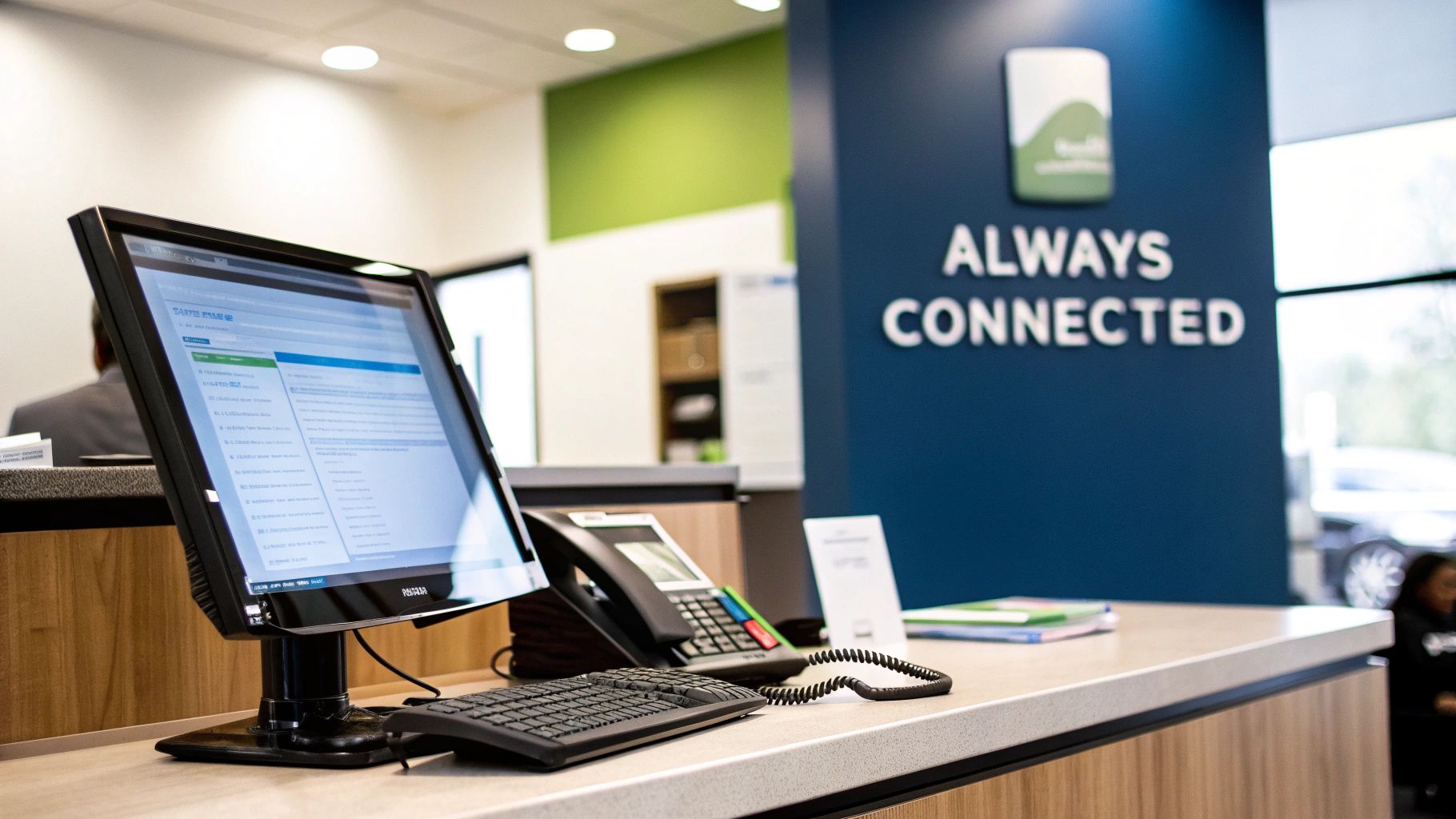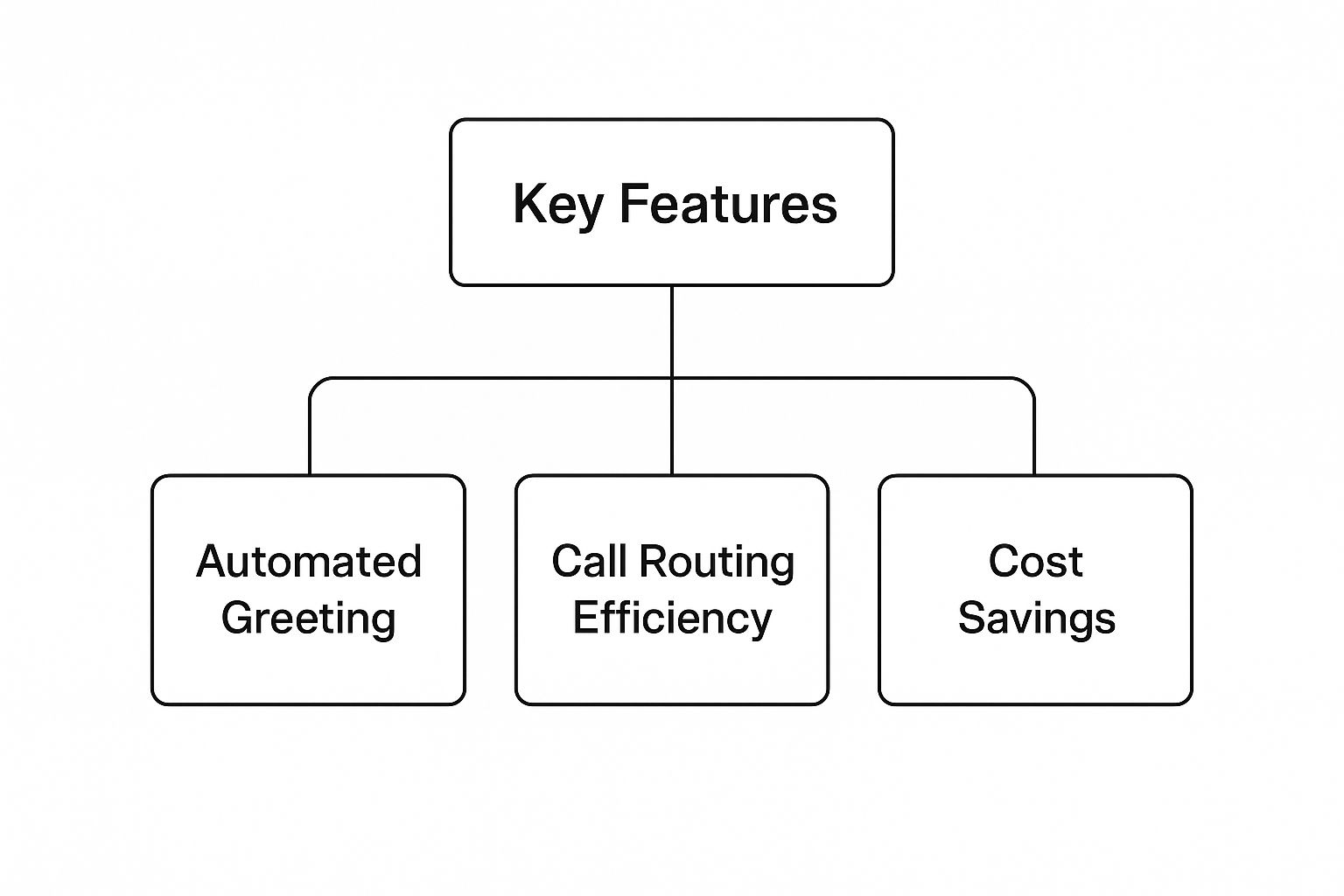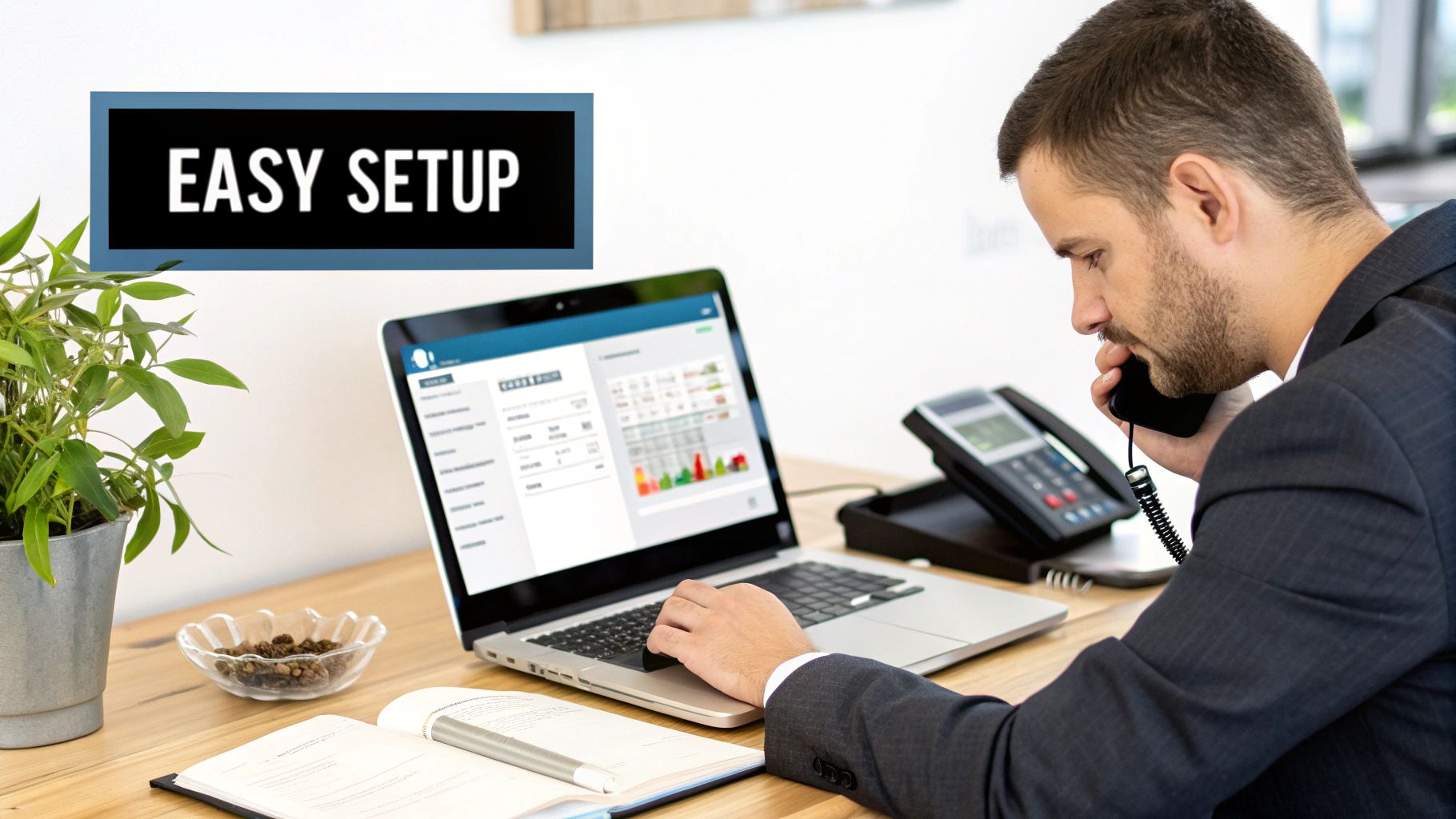A modern small business phone answering system isn't just a glorified voicemail box. It's a powerful engine designed to capture every lead, answer every question, and make sure no customer ever feels like they're shouting into the void.
Think of it as your most reliable employee—the one who works 24/7 without ever needing a coffee break. This kind of system brings order to your customer communications, transforming your business phone from a source of stress into a serious strategic advantage.
Picture your business as a brick-and-mortar shop. Would you ever just walk away from the front counter for hours at a time, letting potential customers wander in, look around, and leave without anyone saying a word? Of course not.
But that’s exactly what happens every time a call to your business rings endlessly or gets dumped into a generic, impersonal voicemail box.

This isn’t just a small hiccup; it’s a silent business killer. Every single missed call chips away at your bottom line and your hard-earned reputation. Today's customers demand immediate answers. If they can’t get them from you, they'll get them from your competitor down the street in a matter of seconds.
Most business owners have no idea just how big this problem really is. A study that monitored call performance at small and mid-sized businesses uncovered a truly shocking reality.
Over a 30-day period, these businesses only managed to answer 37.8% of their incoming calls. Another 37.9% were sent straight to voicemail, and a staggering 24.3% of calls got no answer at all—they just rang and rang.
Let that sink in for a minute. Almost two out of every three people who called couldn't speak to a human being. This isn't just a minor customer service fumble; it's a direct threat to your ability to grow. Digging into the full danger of missed calls shows just how quickly these missed opportunities snowball into major financial losses.
The fallout from a bad phone setup sends ripples across your entire company, causing problems that are often difficult to trace back to the source.
A basic phone line just can't handle the demands of a modern business. A small business phone answering system is the solution, acting as your front-line defense. It ensures every caller is greeted professionally, their needs are understood, and their information is captured, turning every inbound call from a potential problem into a secured opportunity.
It wasn't that long ago that a small business's "phone strategy" was a dusty landline and a clunky answering machine humming in the corner. You know the one—with the tiny cassette tape inside. When a customer called after hours, they got a tinny, pre-recorded message. For its time, it was revolutionary, but it was also a digital dead end.

Jumping from that old setup to a modern small business phone answering system is like swapping a legal pad for a dedicated executive assistant. Sure, the notepad can take a message after the fact, but the assistant can interact, schedule appointments, and solve problems on the spot. This incredible leap forward happened because of a fundamental change in how phone calls work.
The secret sauce behind this whole transformation is Voice over Internet Protocol, or as most people know it, VoIP. It sounds complicated, but the idea is simple: VoIP lets you make and receive phone calls using your internet connection instead of old-school copper phone lines.
That one change demolished the physical walls of old phone systems. Instead of being chained to a specific wire in a specific building, your business phone number became a flexible, digital tool you could manage from anywhere. All of a sudden, features that were once the exclusive domain of giant corporations with million-dollar IT budgets were available to any small business owner.
The global shift to this technology is massive. The worldwide VoIP market is on track to hit a jaw-dropping $55 billion by early 2025. This explosion shows just how quickly businesses are ditching outdated landlines for more powerful, internet-based tools. If you want to dig deeper into this trend, these VoIP statistics from Global Tech Stack paint a very clear picture.
Going digital unlocks a universe of possibilities that would have seemed like pure science fiction just a generation ago.
A VoIP-based system turns a simple phone number into a dynamic front door for your entire business. It's no longer about just answering calls; it's about intelligently managing every single customer interaction.
The difference between the old and new ways is truly night and day. An old answering machine was a passive device; it just sat there, recording information after you'd already missed the chance to connect. A modern system, on the other hand, is an active participant in your business.
Think about how much things have changed:
This evolution means a small business phone answering system isn't just a safety net for missed calls anymore. It's a powerful engine for creating a seamless, professional, and hyper-efficient communication experience that helps you capture more leads, serve customers better, and grow your business.
A modern small business phone answering system isn’t just a piece of technology; it’s a powerhouse of features working in concert to keep your communications flowing smoothly. Getting to know these core components is the first step toward choosing a system that does more than just answer calls—it actively helps you run your business better. These aren't just technical add-ons; they are practical tools designed to solve real-world business headaches.
Think of it like this: if your business is a bustling café, these features are your all-star team. They're the friendly host greeting every customer, the smart traffic manager guiding them to the right table, and the organized barista making sure every order is perfect, even during the morning rush.
This diagram breaks down how key features contribute directly to major business wins like better first impressions, smarter call handling, and ultimately, cost savings.

As you can see, a professional greeting and smart call routing are the building blocks that lead to a better customer experience and a healthier bottom line.
Let's dive into the four essential features you'll find in almost any great system.
First up is the auto-attendant. This is your digital receptionist, working around the clock to greet every caller with a professional and consistent message. It’s the welcoming voice that says, "Thanks for calling [Your Business Name]," and then offers a simple menu to guide them.
This feature is more important than you might think. A study by Vonage found that 85% of consumers have hung up after reaching a poorly designed auto-attendant. It’s a stark reminder that a clear, simple greeting is crucial for guiding callers, not frustrating them.
For instance, a caller might hear, "Press 1 for sales, Press 2 for support, or Press 3 for our store hours." This immediately sorts callers and gets them where they need to go, saving everyone a ton of time.
Once the auto-attendant has greeted the caller, intelligent call routing steps in. Think of this as the smart traffic director for your phone lines. It ensures every call gets to the right person or department automatically, without you or your team having to lift a finger.
Modern systems offer incredibly flexible routing options. You can send calls to different places based on:
This way, high-priority calls get the immediate attention they need, while routine questions are handled efficiently without disrupting your team.
Gone are the days of dialing into a clunky voicemail box and frantically scribbling down messages. One of the most game-changing features of a modern phone system is voicemail-to-email with transcription.
When someone leaves a message, the system converts it into an audio file and zips it over to your email. Better yet, most systems also transcribe the message into text. This means you can read your voicemails right on your phone or computer, just like a text. Stuck in a meeting when a voicemail comes in? No need to step out—just scan the transcription to see if it's urgent. It's a massive productivity win.
For businesses looking for the next level of automation, exploring the features of an AI receptionist for small businesses can unlock even more powerful capabilities.
Finally, mobile app integration cuts the cord, freeing your business phone from your desk. A dedicated mobile app puts your entire phone system right in your pocket.
With a good mobile app, you can:
This is a non-negotiable for any business owner who isn’t stuck behind a desk all day. Whether you're a plumber at a job site or a consultant traveling to meet a client, you can stay connected and maintain a professional presence at all times.
As you evaluate different systems, it's helpful to distinguish between the core features every business needs and the more advanced options that support growth. This table breaks down the essentials versus the nice-to-haves.
While every business should start with the essentials, keeping an eye on the advanced features will help you choose a system that can scale with you as your needs evolve.
A modern small business phone answering system can do so much more than just field calls. Once you get past the basic features, you’ll find a whole suite of powerful tools designed to be a strategic engine for growth. It’s like upgrading from a basic car that gets you from A to B to one with a full diagnostic dashboard, giving you rich data to optimize every part of the journey.
These advanced capabilities turn your phone system into a genuine source of business intelligence. They uncover insights, create efficiencies, and contribute directly to your bottom line, transforming what was once a simple utility into a real competitive advantage.

One of the most powerful advanced features is Customer Relationship Management (CRM) integration. This connects your phone system directly to the database where you keep all your customer information. The result? A seamless flow of data that puts your team in the driver's seat on every single call.
Imagine a loyal customer rings your support line. Instead of your agent fumbling to ask for their name and account number, the phone system automatically recognizes the caller's number. Instantly, a "screen-pop" appears on the agent's computer displaying the customer’s entire history: past purchases, previous support tickets, and any relevant notes.
This simple connection completely changes the conversation.
By integrating your phone system with your CRM, you break down those frustrating information silos and arm your team with the knowledge they need to provide exceptional service.
Beyond just basic call logs, today’s advanced systems use Artificial Intelligence (AI) to analyze conversations and pull out valuable insights you’d otherwise miss entirely. This is where that diagnostic dashboard really comes to life, revealing communication patterns that can help guide your entire business strategy.
These platforms are constantly getting smarter. It's now routine for a small business phone answering system to have AI-powered analytics, intelligent call routing, and deep CRM connections. Some can even boost outbound call volume by up to 120% with automated dialers and use conversation intelligence to supercharge agent coaching.
AI-powered features can give you:
These analytics provide objective, data-driven feedback that helps you refine sales scripts, improve customer service, and make smarter decisions across the board. For anyone curious about how AI directs calls, our guide on how AI call routing works offers a much deeper explanation.
An advanced phone system isn't just for waiting for the phone to ring; it's also a powerhouse for proactive outreach. Features like power dialers and click-to-call were built for sales and customer success teams who need to connect with a lot of people, efficiently.
A power dialer automatically dials numbers from a list you've loaded, only connecting your agent when a live person picks up. This completely eliminates the time wasted on manual dialing, busy signals, and unanswered calls, letting your team focus on what they do best: talking to people.
But it's not just about traditional phone calls anymore. Top-tier systems can bring in other communication channels, including direct messaging platforms. For businesses wanting to meet customers on their preferred turf, integrating WhatsApp can be a massive advantage. This omnichannel approach ensures you can reach your audience wherever they are, creating a unified and seamless communication experience that truly accelerates growth.
Picking the right small business phone answering system can feel like a huge decision. With a sea of providers and feature lists, it's easy to get lost in the noise. But it doesn't have to be overwhelming. The secret is to stop focusing on the technology for a moment and start with what your business actually needs to get done.
It's a bit like choosing a work vehicle. A caterer needs a spacious van, a contractor needs a tough truck, and a consultant might just need a reliable sedan. The "best" vehicle is the one that's perfect for the job. In the same way, the best phone system is the one that fits your budget, team size, and daily workflow like a glove.
Before you even glance at a feature, you need to get a handle on the pricing. Most providers operate on one of two models: per-user, per-month or a flat-rate plan.
Let's think about a fictional business owner, "Dave the Plumber." Dave has two office staff and three plumbers who are always out on jobs. A per-user plan for all five of them could get pricey fast. An AI system with a flat rate that can screen all incoming calls and only push real emergencies to his plumbers' cell phones? Now that sounds like a much smarter, budget-friendly fit.
Scalability is something a lot of small business owners don't think about until it's too late. The system you pick today absolutely must be able to support your business tomorrow, next year, and five years from now. Don't just solve for today; think about where you're headed.
Ask yourself these questions:
A system that seems like a steal for a two-person operation might become a massive expense for a ten-person team. You want a partner that scales with your success, not a tool that puts a ceiling on it.
The most powerful system on the planet is worthless if your team finds it too confusing to use. A modern small business phone answering system should be built for regular people, not IT wizards. Setup and daily management should all happen in a clean, intuitive online dashboard.
Your team is busy running the business; they don't have time to become phone system experts. The ideal system should feel as easy to use as a smartphone app, not a complex piece of enterprise software.
Before you sign anything, demand a demo or a free trial. Get your hands on it. See how easy it is to record a greeting, create a call-routing rule, or add a new team member. If you can't figure it out in a few minutes, that’s a major red flag. For a straightforward look at different options, you can check out this comparison of AI call services to see how their interfaces and features stack up against each other.
Your phone system shouldn't be stranded on a digital island. It needs to talk to the other tools you rely on every day. Integration capabilities are what elevate a simple phone line into a true command center for your business.
Let's go back to Dave the Plumber. He uses specific scheduling software to book his jobs. A phone system that integrates with his calendar is a total game-changer. An AI receptionist could check his availability in real-time and book a non-emergency job for a caller without any human help. That saves time, slashes booking errors, and frees up his office staff to focus on bigger things.
The most important integrations to look for are:
When your phones go down, your business grinds to a halt. In that moment, you will be incredibly thankful you chose a provider with fantastic, responsive customer support. As you're evaluating your options, dig into their support. Is it just email, or can you actually get a human on the phone? Do they offer 24/7 help for emergencies? Read the reviews and see what real customers say about their support experiences. A low price tag means nothing if you're left stranded when you need help the most.
Making a change to your business's phone setup can bring up a few last-minute questions, even when you feel you have a solid plan. That's totally normal. Here, we'll tackle the most common things business owners ask us, giving you straight-up answers so you can move forward with confidence.
Yes, absolutely. This is probably the number one concern we hear, and the answer is a big, resounding "yes."
Just about every modern VoIP provider or AI receptionist service lets you "port" your existing number over. It’s a standardized, seamless process. This means no reprinting business cards, no updating your website, and no messing with your Google Business Profile. The whole thing usually takes a few business days, and your new provider will walk you through every simple step.
Not anymore. That old idea that a powerful phone system is only for the big players is completely out of date. The move to internet-based calling has made these tools incredibly affordable for everyone.
Many of the best providers have plans starting around $20 to $30 per user, per month. That's often less than what you’d pay for an old-school business landline. When you think about the cost of just one lost lead, or one frustrated customer who couldn't reach you, the system pays for itself almost immediately.
Honestly, it’s easier than you think. Modern phone systems are designed for busy entrepreneurs, not IT wizards. You won't need a technical background or a dedicated support person to get it all running.
The entire setup is typically handled through a simple online dashboard. Most of the time, getting started involves just three things:
Most small business owners get this done in under an hour, often with a helpful guide from the provider's support team. It’s built to be a "plug-and-play" experience so you can get back to what you do best.
That's a fantastic question. People sometimes use these terms interchangeably, but they refer to very different things. Nailing this distinction is key to picking the right tool for your business.
An auto-attendant is your basic digital switchboard operator. It's the simple, pre-recorded menu you're used to hearing: "Press 1 for sales, Press 2 for support." It’s a great tool for routing calls to the right place.
A virtual receptionist, on the other hand, is a much more sophisticated solution. The term can mean one of two things:
Think of it this way: an auto-attendant is a standard feature that directs traffic. A virtual receptionist—whether human or AI—is a premium service that handles the entire interaction for your small business phone answering system.
Ready to stop missing calls and start turning every ring into a real opportunity? My AI Front Desk offers an intelligent AI receptionist that works 24/7 to answer calls, book appointments, and manage customer conversations. It’s the most reliable employee you’ll ever hire.
Explore how our AI receptionist can transform your business today.
Start your free trial for My AI Front Desk today, it takes minutes to setup!








